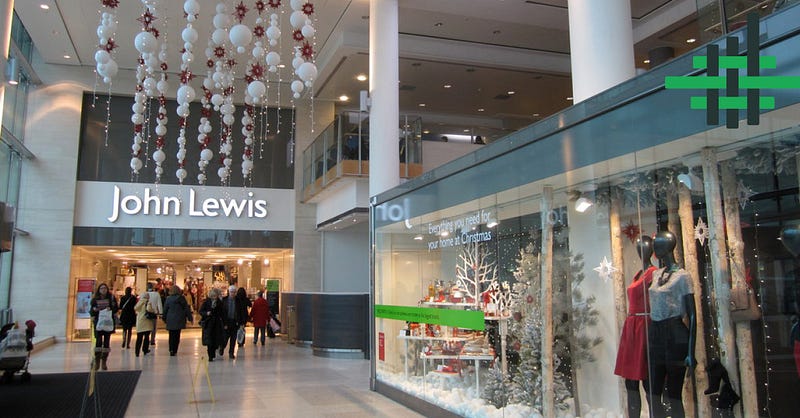The Environmental Performance Record of UK’s John Lewis Partnership
By Sarah Stranahan

The new economy movement often speaks of creating an economy that works for people and the planet. But are those two goals always aligned? Given limited resources and competing needs, how do businesses manage trade-offs between what’s best for people — employees, customers and communities — and what’s best for the planet — i.e., investment in environmentally sustainable products and practices?
The Democracy Collaborative is researching the relationship between employee ownership and environmentally sustainable business practices to explore whether particular enterprise designs (ownership and governance structures) tend to benefit both people and the planet. The John Lewis Partnership in the UK is an instructive example in how the two can go together, but also rely upon external standards created by government.
A Global Leader in Employee Ownership
The John Lewis Partnership (JLP) is one of the oldest and largest employee-owned firms in the world. The JLP group is the third largest UK non-traded company by sales, with 50 department stores, 353 Waitrose convenience stores, and 85,500 employees. It is 100 percent owned by employees. The firm began back in 1854, when John Lewis opened a drapery shop in London, and grew the business into a chain of successful department stores. Part of his management strategy was to extract as much value as possible from labor. His son, Spedan Lewis, had different management ideas.
Spedan believed that employees deserved a significant share of the profits that they worked to produce, and that businesses could thrive when the interests of the workers were aligned with the long-term success of the business. In 1929, Spedan, who had inherited the business, placed it in a trust that distributed the profits to the employees, and in 1950, he transferred ownership of the trust to the employees, whom he called “partners.” In many ways, Spedan Lewis foreshadowed the basic structure of an Employee Stock Ownership Plan (ESOP) conversion. The purpose of the partnership, according to the company mission, is “The happiness of its members through their worthwhile and satisfying employment in a successful business.”
Employee Ownership Benefits Workers
This mission is a real one at JLP, which each year distributes generally between 40 and 60 percent of after-tax profits in a “partnership bonus” to employees. Over the past five years, employees have received an average bonus equal to 9.4 percent of their wages, more than a month’s pay. The average non-management wage is 18 percent higher than the national average, and employees have generous health and vacation benefits, opportunities for training, and a role in company governance through the Partnership Council.
Commitment to Environmental Sustainability
In addition to its commitment to its employees, JLP has set ambitious environmental goals, as detailed in it Corporate Responsibility report. The company carefully measures not just its carbon impact but a whole set of environmental metrics, is improving its supply chain, and verifies its reporting with an environmental auditor. Its goals include carbon, water, and waste reduction; recycling; supply chain standards around sustainably sourced timber, cotton, palm oil, and tuna; and also protection of human and animal rights.
Some of JLP’s highlighted accomplishments are impressive: the company exceeded its goal of 65 percent carbon reduction against a 2010 baseline; its store brand tea is 100 percent fair-trade certified; and it is committed to making 100 percent of its own brand packaging recyclable, reusable or compostable by 2025.
Surprisingly, despite its ambitious environmental goals and accomplishments, Ethical Consumer, a UK organization dedicated to making global business more sustainable through consumer pressure, gave JLP only a “middle rating” for environmental reporting.
“John Lewis Partnership had an up-to-date environmental policy, provided more than two quantified environmental reduction targets, provided meaningful carbon disclosure and the company engaged KPMG LLP to undertake an independent limited assurance engagement over selected environmental information. However, the company did not show a reasonable understanding of its main impacts as it had no clear toxics policies for clothing and electronics, and only the data within its CSR reporting had been independently verified.”
UK Mandatory GHG Reporting: Does it Make a Difference?
How could a company with such a robust set of sustainable goals, high standards of measurement, and commitment to action get only a “middle rating”? It appears that the “middle” in the UK is different than the “middle” in the US. Is this because the UK has mandatory greenhouse gas reporting for all publicly traded companies?
According to Carbon Trust, The UK Government has announced that under the Companies Act 2006 (Strategic and Directors’ Reports) Regulations 2013, quoted companies are required to report their annual greenhouse gas (GHG) emissions in their directors’ report. Carbon reporting is the first vital step for companies to make reductions in emissions.
Clearly, compared to the US, UK companies must meet a higher environmental standard. But JLP is not publicly traded, so actually it isn’t required to meet this legislative standard. It did so voluntarily, because it’s employee-elected governance body agreed that it was the right thing to do.
Did employee ownership push JLP in the right direction, or did the regulatory framework created by the British Parliament influence corporate policies? JLP’s story suggests that both may be true: Regulatory frameworks and improved enterprise design work hand in hand. If we want to create businesses that support people and the planet, we need to evolve enterprise design. But we also need to harness and regulate enterprises and markets to ensure they operate for the benefit of both people and the planet.
— Sarah Stranahan, Senior Editorial Associate at The Democracy Collaborative, and a leading member of its Fifty by Fifty employee ownership team.
Fifty by Fifty is working to transform the U.S. economy by growing employee ownership. Join our campaign, and we’ll send our monthly newsletter, filled with great company stories, right to your inbox.
